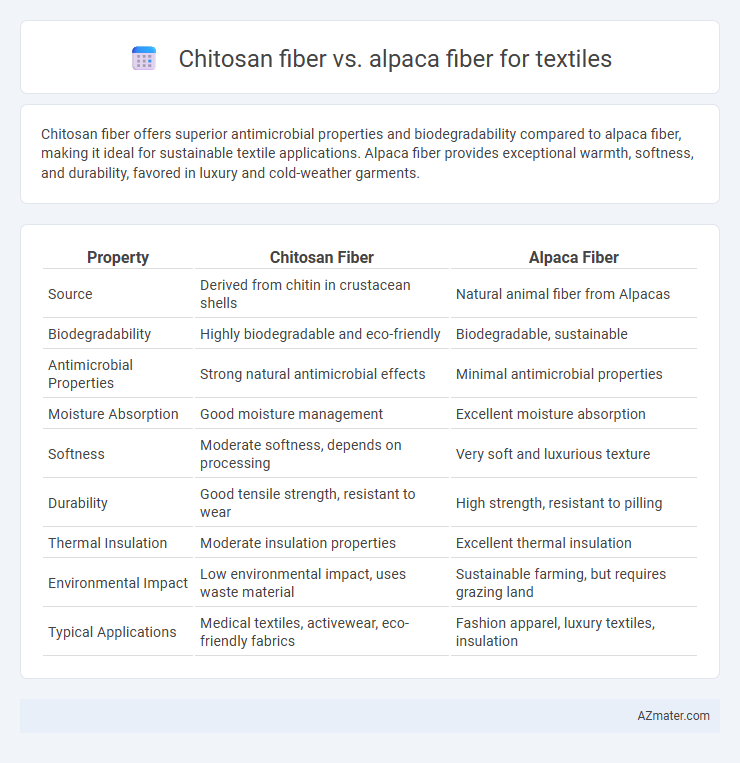Chitosan fiber offers superior antimicrobial properties and biodegradability compared to alpaca fiber, making it ideal for sustainable textile applications. Alpaca fiber provides exceptional warmth, softness, and durability, favored in luxury and cold-weather garments.
Table of Comparison
| Property | Chitosan Fiber | Alpaca Fiber |
|---|---|---|
| Source | Derived from chitin in crustacean shells | Natural animal fiber from Alpacas |
| Biodegradability | Highly biodegradable and eco-friendly | Biodegradable, sustainable |
| Antimicrobial Properties | Strong natural antimicrobial effects | Minimal antimicrobial properties |
| Moisture Absorption | Good moisture management | Excellent moisture absorption |
| Softness | Moderate softness, depends on processing | Very soft and luxurious texture |
| Durability | Good tensile strength, resistant to wear | High strength, resistant to pilling |
| Thermal Insulation | Moderate insulation properties | Excellent thermal insulation |
| Environmental Impact | Low environmental impact, uses waste material | Sustainable farming, but requires grazing land |
| Typical Applications | Medical textiles, activewear, eco-friendly fabrics | Fashion apparel, luxury textiles, insulation |
Overview of Chitosan Fiber and Alpaca Fiber
Chitosan fiber, derived from chitin found in crustacean shells, is a biocompatible textile material praised for its antimicrobial properties and biodegradability, making it suitable for medical and hygiene applications. Alpaca fiber, obtained from the alpaca animal native to South America, is valued for its softness, thermal insulation, and hypoallergenic qualities, making it ideal for luxury apparel and cold-weather garments. Both fibers offer unique benefits in sustainability and comfort, with chitosan focusing on functional performance and alpaca emphasizing natural warmth and softness.
Source and Sustainability Comparison
Chitosan fiber is derived from chitin, primarily sourced from crustacean shells, offering a biodegradable and renewable option that utilizes seafood industry waste, enhancing its sustainability profile. Alpaca fiber, harvested from alpacas native to the Andes, is a natural animal protein fiber known for its eco-friendly properties due to minimal environmental impact and sustainable animal farming practices. Both fibers contribute to sustainable textile production, with chitosan leveraging waste valorization and alpaca fiber emphasizing ethical animal sourcing and carbon-neutral farming benefits.
Fiber Structure and Composition Differences
Chitosan fiber is derived from chitin, a natural polysaccharide found in crustacean shells, featuring a semi-crystalline structure with amino groups that confer antimicrobial properties and moisture retention. Alpaca fiber consists primarily of keratin protein with a scaly surface and a hollow medulla, providing excellent thermal insulation and softness due to its fine diameter and low micron count. The biochemical composition of chitosan fibers leads to biodegradability and inherent bioactivity, while alpaca fibers offer superior warmth and elasticity because of keratin's fibrous protein matrix.
Mechanical Properties: Strength and Durability
Chitosan fiber exhibits high tensile strength and excellent durability due to its natural polymer structure, making it resistant to wear and tear in textile applications. Alpaca fiber offers superior softness and flexibility but has moderate tensile strength and less durability compared to chitosan fiber. For high-performance textiles requiring long-lasting mechanical integrity, chitosan fiber provides enhanced strength and sustained durability over alpaca fiber.
Moisture Absorption and Breathability
Chitosan fiber exhibits superior moisture absorption due to its hydrophilic amino groups, enhancing sweat-wicking properties and maintaining dryness in textiles. Alpaca fiber offers exceptional breathability with its hollow core, allowing efficient air circulation and temperature regulation while also providing natural moisture management. Both fibers contribute to comfort in clothing, but chitosan's bioactive properties add antimicrobial benefits alongside moisture control.
Comfort and Skin Sensitivity
Chitosan fiber exhibits superior antimicrobial properties and moisture-wicking abilities, enhancing comfort and reducing irritation for sensitive skin compared to traditional alpaca fiber. Alpaca fiber offers natural warmth and softness due to its fine micron count, but may cause itchiness for individuals with highly sensitive skin. The hypoallergenic nature of chitosan fiber, derived from crustacean shells, makes it a preferred choice for textiles aimed at allergy-prone or delicate skin, providing breathable and gentle fabric performance.
Antimicrobial Properties: Chitosan vs Alpaca
Chitosan fiber exhibits strong antimicrobial properties due to its natural ability to inhibit the growth of bacteria, fungi, and other pathogens, making it ideal for hygienic textile applications. Alpaca fiber, while prized for its softness and thermal insulation, lacks inherent antimicrobial characteristics and generally requires chemical treatments to achieve similar effects. The antimicrobial efficacy of chitosan fibers is attributed to their positive charge, which disrupts microbial cell membranes, providing a significant advantage over alpaca fibers in health-focused textile products.
Dyeability and Color Retention
Chitosan fiber exhibits superior dyeability due to its natural amino groups, which promote strong ionic bonding with various dye molecules, resulting in vibrant and uniform coloration. Alpaca fiber, while valued for its softness and durability, has a waxy surface that challenges dye uptake, often requiring pre-treatment for effective dyeing. In terms of color retention, chitosan fiber demonstrates excellent resistance to fading under light exposure and washing, whereas alpaca fiber tends to retain color well but may show gradual fading over time if not properly cared for.
Environmental Impact in Textile Industry
Chitosan fiber, derived from crustacean shell waste, offers a sustainable alternative due to its biodegradability and minimal reliance on water-intensive processes compared to traditional animal fibers. Alpaca fiber, while natural and biodegradable, requires significant land and water resources, and its farming can contribute to greenhouse gas emissions. The textile industry benefits environmentally from chitosan fiber through waste valorization and reduced ecological footprint, whereas alpaca fiber sustainability depends heavily on responsible farming practices.
Applications and Future Trends
Chitosan fiber, derived from chitin found in crustacean shells, offers antimicrobial properties and biodegradability, making it ideal for medical textiles and activewear. Alpaca fiber, prized for its softness, thermal insulation, and hypoallergenic qualities, is commonly used in luxury apparel and home textiles. Future trends indicate increasing integration of chitosan fiber in sustainable and functional fabrics, while alpaca fiber demand grows with eco-friendly fashion and innovative blending techniques.

Infographic: Chitosan fiber vs Alpaca fiber for Textile
 azmater.com
azmater.com